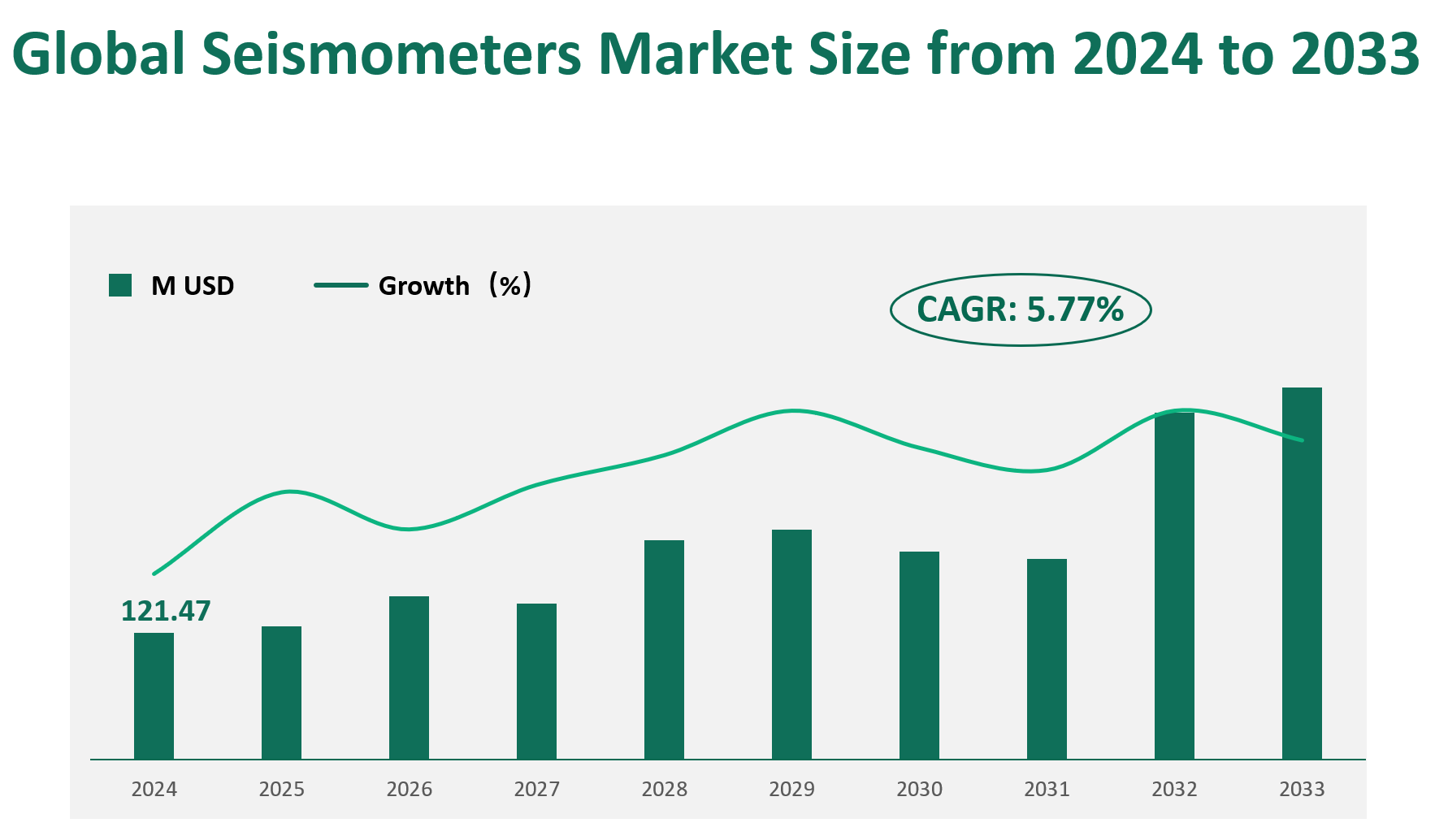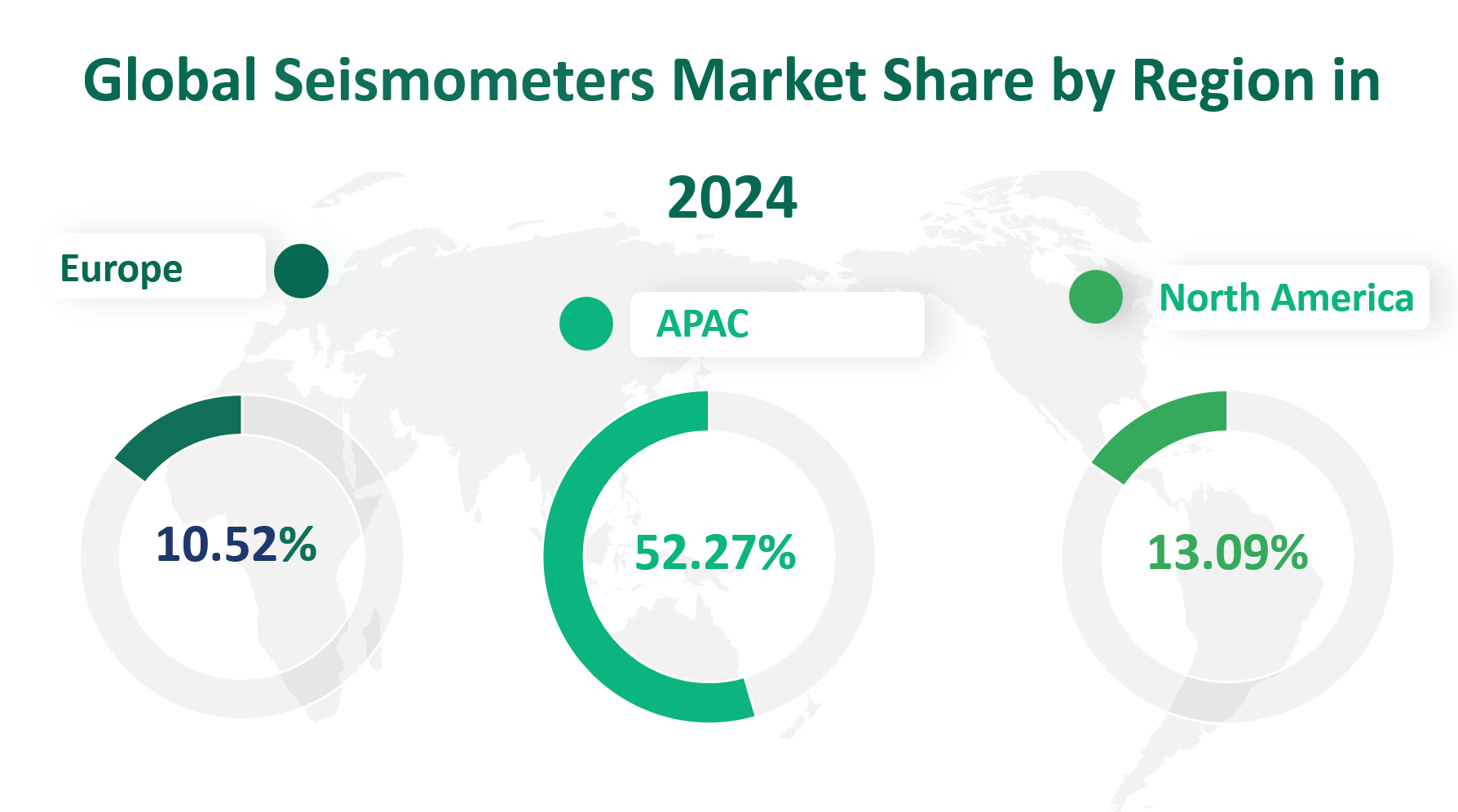1. Global Seismometers Market Revenue and Future Growth
The global seismometers market revenue reached 121.47 million USD in 2024. The market is projected to grow at a Compound Annual Growth Rate (CAGR) of 5.77% from 2024 to 2033.
A seismometer is an instrument designed to detect and record earthquakes. It typically consists of a mass attached to a fixed base. During an earthquake, the base moves while the mass remains relatively stationary. Seismometers are usually combined with sensor digitizers and recorders to produce seismograms. These devices are crucial for locating and characterizing earthquakes and studying the Earth’s internal structure. They are primarily used in scientific research, government projects, and engineering projects.
Figure Global Seismometers Market Size (M USD) and CAGR (2024-2033)

2. Seismometers Market Growth Drivers and Restraints
The growth of the seismometers market is driven by several key factors. Firstly, the increasing demand for scientific research is a significant driver. Projects like the Earth Scope, funded by the National Science Foundation, have installed dense seismometer arrays across the continental U.S. and Alaska to study the Earth’s interior and earthquake characteristics.
Secondly, the need for disaster preparedness and mitigation is growing. By analyzing earthquake frequency and magnitude, seismometer can help in the development of earthquake-resistant building codes and reduce the impact of aftershocks. Thirdly, the exploration of the ocean, which accounts for 71% of the Earth’s surface, is driving the demand for marine seismometer. These devices are essential for studying the geological structure of the seabed and detecting underwater earthquakes or tsunamis.
However, the market also faces several limiting factors. The reliability of information is a concern, as seismometer can be affected by human activities and natural environmental factors, leading to potential misreporting of earthquakes. The cost and complexity of seismometer also pose challenges. They are generally expensive to manufacture and difficult to modify once produced, which restricts their mass production and market penetration. Additionally, the market scope is currently limited to scientific research and engineering, and finding ways to expand their use and reduce costs is not straightforward.
3. Seismometers Market Technology Innovation and Corporate Mergers and Acquisitions
The seismometers market is experiencing technological innovation and corporate activity. Technological advancements have led to the development of portable, small-type seismometers and even smartphone apps that can turn mobile phones into seismometers. These innovations are expected to expand the market and make seismometers more accessible.
Corporate mergers and acquisitions are also shaping the market. For example, ABEM and MALÅ merged to form Guideline Geo in 2012, combining their expertise in geophysical solutions and ground-penetrating radar technology. This merger has allowed Guideline Geo to strengthen its market position and focus on the Chinese market by establishing a new distributor, Beijing Zhong Rui Geophysical Technology Co., Ltd. Furthermore, key product launches such as Kinemetrics’ Very Broadband Model STS-5A-360 and Guralp’s Certimus medium-motion seismic station have introduced new capabilities and ease of use to the market. These developments indicate that the seismometers market is not only growing in size but also evolving in terms of technology and corporate structure.
4. Analyzing the Different Types of Seismometers Market
Seismometers are categorized into three primary types based on their operational characteristics and applications: Short Period, Intermediate Period, and Long Period.
Short Period Seismometers are designed to detect high-frequency seismic waves, typically used for monitoring local and regional earthquakes. They are highly sensitive to small, rapid ground movements and are crucial for early warning systems and detailed seismic studies in areas with frequent seismic activity. The market Revenue is $34.34 million in 2024.
Intermediate Period Seismometers are designed to capture seismic waves with a broader frequency range, making them suitable for both local and teleseismic events. They provide a balance between sensitivity and coverage, making them versatile for various applications, including research and engineering projects. The market Revenue is $47.16 million in 2024.
Intermediate Period Seismometers have the largest market share among the three types. Their versatility and ability to provide comprehensive seismic data make them a preferred choice for a wide range of applications. The growth rate of this segment is robust, driven by the increasing demand from the scientific community for detailed seismic studies and from the engineering sector for site assessments and monitoring during construction projects.
Long Period Seismometers are specialized instruments designed to detect low-frequency seismic waves, often associated with large-scale tectonic movements and distant earthquakes. They are crucial for studying the Earth’s deep internal structure and long-term seismic processes. The market Revenue is $39.98 million in 2024.
Table Global Seismometers Market Size by Type in 2024
|
Type |
Market Size (M USD) 2024 |
|
Short Period |
34.34 |
|
Intermediate Period |
47.16 |
|
Long Period |
39.98 |
5. Analyzing the Different Applications of the Seismometers Market
Marine Seismometers are designed to operate in underwater environments, providing critical data for oceanographic research, seabed exploration, and monitoring of underwater seismic events. They are essential for understanding the geological structure of the ocean floor and detecting potential hazards such as underwater landslides and tsunamis. The market Revenue is $35.13 million in 2024.
Land Seismometers are the most common type, used for monitoring seismic activity on land. They are deployed in various settings, including urban areas, rural regions, and near critical infrastructure, to provide early warnings and support disaster management efforts. They are also used in engineering projects for site assessments and monitoring during construction. The market Revenue is $86.34 million in 2024.
Land applications have the largest market share, reflecting the widespread need for seismic monitoring in terrestrial environments. The growth rate of this segment is robust, driven by the increasing urbanization and the need to protect growing populations and infrastructure from seismic hazards.
Table Global Seismometers Market Size by Application in 2024
|
Application |
Market Size (M USD) 2024 |
|
Marine |
35.13 |
|
Land |
86.34 |
6. Global Seismometers Market Size by Region
The Asia-Pacific region is the largest market for Seismometers, driven by the high demand for seismic monitoring due to the region’s significant seismic activity. Countries like China and Japan, which are prone to earthquakes, have extensive seismic monitoring networks. The market is also supported by government initiatives to enhance disaster preparedness and response capabilities. The market Revenue is $63.49 million in 2024.
North America, particularly the United States, has a well-established market for Seismometers. The region’s advanced technological infrastructure and high research and development spending contribute to its market size. The United States has a dense network of seismic monitoring stations, especially in seismically active areas like California. The market is also driven by the need for accurate seismic data for urban planning and infrastructure safety. The market Revenue is $15.90 million in 2024.
Europe’s Seismometers market is influenced by its diverse geological conditions and the need for seismic monitoring in various countries. The region has a strong focus on scientific research and collaboration, leading to significant investments in seismic monitoring technology. The market Revenue is $12.78 million in 2024.
South America’s market for Seismometers is growing rapidly, driven by the region’s increasing awareness of seismic risks and the need for better disaster management. The market Revenue is $23.12 million in 2024.
The Middle East and Africa region is a growing market for Seismometers, driven by the need for seismic monitoring in resource-rich areas and seismically active regions. The Middle East and Africa region revenue is $6.17 million in 2024.
Figure Global Seismometers Market Size by Region in 2024

7. Global Seismometers Market Analysis by Major Players
7.1 Guralp
Company Introduction and Business Overview:
Guralp Systems Ltd, established in 1985 and headquartered in the United Kingdom, is a leading global provider of broadband seismic instrumentation. The company designs and manufactures land-based, ocean-bottom, and borehole instrumentation, serving clients worldwide.
Products Offered:
Ocean Bottom Seismometers (OBS)
Broadband Seismometers
Portable Seismometers
7.2 Geometrics
Company Introduction and Business Overview:
Geometrics, established in 1969 and headquartered in the United States, is a member of the OYO Corporation. The company specializes in designing and manufacturing seismographs, magnetometers, and geoelectric instruments, with applications in minerals, oil & gas, unexploded ordinance, and utilities.
Products Offered:
Marine Seismographs (GeoEel Solid Digital Streamer)
Land Seismographs (Geode)
Exploration Seismographs
7.3 Geotech Instruments LLC
Company Introduction and Business Overview:
Geotech Instruments LLC, established in 1960 and headquartered in the United States, manufactures measuring and controlling devices. The company’s products are used in research, seismic surveys, civil engineering, microzonation, industrial vibrations, and education.
Products Offered:
Short-period Seismometers (Model S-13)
Portable Seismometers
Seismic Monitoring Systems
7.4 Guideline Geo
Company Introduction and Business Overview:
Guideline Geo, established in 1923 and headquartered in Sweden, develops and markets technology for infrastructure maintenance, groundwater mapping, and raw material and energy exploitation. The company offers a range of geophysical instruments and services globally.
Products Offered:
Ground-penetrating Radar (GPR)
Resistivity Meters
Seismographs (ABEM Terraloc Pro 2)
7.5 Vibrock
Company Introduction and Business Overview:
Vibrock, established and headquartered in the United Kingdom, provides sales and hires of specialist equipment. The company offers services within the UK and abroad, including repair and calibration facilities to maintain the continuity of monitoring operations.
Products Offered:
V901-GSM Seismograph
Portable Seismometers
Monitoring and Calibration Services

